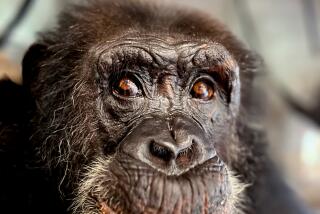Monkey see, monkey kill: The evolutionary roots of lethal combat
- Share via
The killings are often swift and brutal: An overwhelming force of chimpanzees will pin their fellow primate to the ground as dozens of attackers commence to biting, punching, kicking and ripping at the victim’s body.
“They’ll tear off pieces of the body, often the genitalia, and sometimes they’ll rip the throat out. It’s really horrific, the sorts of damage they do,” said Michael Wilson, a University of Minnesota evolutionary anthropologist who has studied chimps in the wild.
Researchers have long debated the reasons as to why our closest living animal cousins would exercise deadly violence against their own kind -- including many helpless infants.
One school of thought argues that violence among Pan troglodytes is the result of human encroachment on chimpanzee habitat. Feeding by researchers -- a now discontinued practice -- poaching, deforestation and other human activities have prompted desperate and uncharacteristic behavior they argue.
But the opposite, and perhaps darker, point of view holds that all this bloodshed is an adaptive survival strategy that predates the arrival of Homo sapiens.
By slaying chimps from competing groups, the killers may in fact expand their territory, and in the process increase their access to food and mates.
In a paper published Wednesday in the journal Nature, Wilson and his colleagues studied 152 cases of lethal aggression among noncaptive chimpanzees and concluded that humans had little to do with sparking the mayhem.
The authors noted, among other findings, that the most chimp-on-chimp violence occurred at a site that was relatively undisturbed by humans -- Uganda’s Kibale National Park -- while little to no violence occurred at a site in Guinea that was most heavily impacted by humans.
“We conclude that patterns of lethal aggression in Pan show little correlation with human impacts, but are instead better explained by the adaptive hypothesis that killing is a means to eliminate rivals when the costs of killing are low,” the authors wrote.
Humans and chimpanzees shared a common ancestor roughly 7 million years ago. Because of this, researchers have scrutinized chimpanzee behavior in hopes of gleaning insights into man’s own use of violence, and particularly his proclivity for warfare.
“Because chimpanzees are so closely related to us, it raises the possibility that maybe these patterns are something that we share because we share them from our common ancestor,” Wilson said.
Wilson said that while it’s been argued that human warfare is the result of a number of factors occurring in the relatively recent past -- the advent of agriculture, the development of weapons and the formation of ideologies -- chimpanzee behavior would suggest warfare has “a long evolutionary history.”
Authors collected decades worth of data from roughly a dozen chimpanzee research sites throughout Africa, collecting eyewitness reports of chimp killings as well as forensic data on suspected slayings.
“It surprised me to learn how many killings there really were,” Wilson said.
It didn’t take long for the researchers to identify some specific patterns.
“Male chimpanzees killed more often than females, and killed mainly male victims,” authors wrote. “Attackers most frequently killed unweaned infants; victims were mainly members of other communities (and thus unlikely to be close kin); and ... killings typically occurred when attackers had an overwhelming numerical advantage.”
What type of number advantage are we talking? The average was five attackers to one victim, but in some instances, as many as 32 attackers would pile onto one hapless victim, researchers found.
“These results should finally put an end to the idea that lethal aggression in chimpanzees is a non-adaptive by-product of anthropogenic influences -- but they will probably not be enough to convince everyone,” wrote Joan Silk, an evolutionary anthropologist at Arizona State University, in an accompanying News & Views piece.
However, Silk cautioned people against jumping to conclusions about what the research says about man. “Humans are not destined to be warlike because chimpanzees sometimes kill their neighbors,” she wrote.
Interestingly, researchers found that even though chimpanzees could be very violent, closely related bonobos, Pan paniscus, were far more easygoing. They could document only one suspected bonobo killing.
Wilson said that though chimpanzee killings could be brutal, they were relatively rare. Most conflicts between competing male-related communities involved groups of chimpanzees shouting at each other from great distances, and one of the groups eventually deciding to move on.
The ferociousness of the violence visited upon noncommunity chimps was rarely if ever visited upon members of the same group. However, there were curious exceptions, Wilson said.
During his observations of chimpanzees at Gombe National Park in Tanzania, Wilson wrote in his blog that he was twice bowled over and intimidated by a famously aggressive alpha male chimp named Frodo (yes, he was named after the fictional Hobbit).
Frodo’s long list of violent deeds included beating famed primatologist Jane Goodall, seizing and killing a human infant, impregnating his mother, attacking filmmakers and researchers, assaulting “Far Side” cartoonist Gary Larson and slaying many, many monkeys. (Despite the headline on this story, chimpanzees are classified as great apes, not monkeys.)
In the end however, Frodo wound up as a victim in the study’s final body count.
He was found dead in November 2013. A necropsy concluded that he had died from an apparent bite to his genitals that had became infected.
Follow @montemorin for science news







